Contents
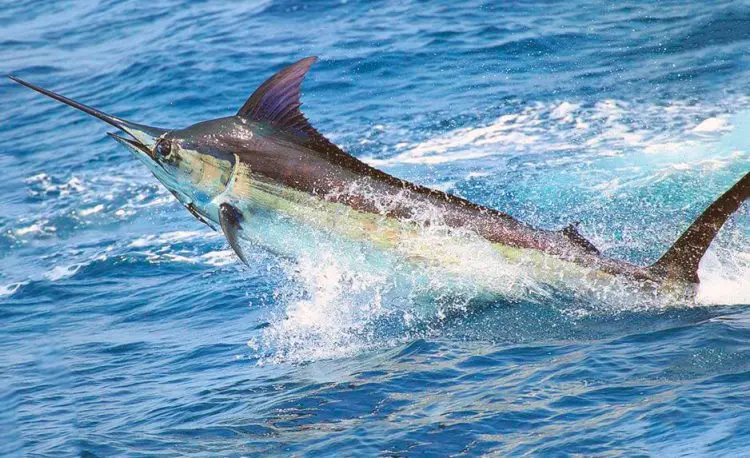
Marlin fish represents the species “Ray-finned” fish and the “Marlin” family. This fish has a relatively low percentage of fat, so it is of commercial interest. In addition, marlin is a popular object of sport fishing.
Marlin fish: description

Two centuries ago, the French ichthyologist Bernard Lacepede described this species using a drawing of this fish. After that, marlin fish began to be assigned various species and generic names.
Currently, marlin has one, recognized by all experts, the name “Makaira nigricans”, which in Greek means “Short Dagger”.
Appearance

The most popular is the “Blue Marlin” or Atlantic Blue Marlin. Adult females are four times the size of adult males. As a rule, the mass of adult males is about 150 kg, while the mass of females is at the level of half a ton, with a body length of up to 5 meters. The distance from the eyes to the tip of the spear is about one-fifth of the marlin’s total body size. It is known about the record weight that this fish possessed – 636 kilograms.
Important information! Blue marlin is distinguished by the presence of two dorsal and two anal fins, which are based on bone rays. In the first dorsal fin, there are on average up to 40 rays, and in the second – there are much fewer of them, only 6-7 rays.
The first anal fin is similar in shape to the second dorsal fin and consists of 15 rays. The pelvic fins are relatively narrow and long, while they can be retracted into special recesses located on the sides of the fish’s body. The pectoral fins are somewhat shorter than the pelvic fins, but they do not have a very developed membrane, and a depression can be seen inside the ventral groove.
The dorsal region of the Atlantic blue marlin is characterized by a dark blue color, and the sides are light, in silvery tones. On the body, you can also see several rows (more than 10) of stripes that have a greenish-blue tint. However, they can be diluted with round dots and thinner stripes. The first dorsal fin is colored dark blue or almost black, without any inclusions of dots or stripes. Other fins are painted in lighter colors. At the base of the anal fins there is a silver tint.
The body of a marlin is covered with thin but elongated scales. The spear is long and strong, and small, file-like teeth grow on the lower and upper jaws.
Interesting fact! In the process of hunting, marlin quickly change their color with the acquisition of a bright blue hue. This is possible thanks to substances such as iridophores, which contain pigments, as well as thanks to special light-reflecting cells.
Thanks to the sensitive lateral line, the fish catches all movements in the water, and also feels changes in atmospheric pressure. Behind the first anal fin is the anus. The blue marlin has twenty-four vertebrae.
Character and lifestyle
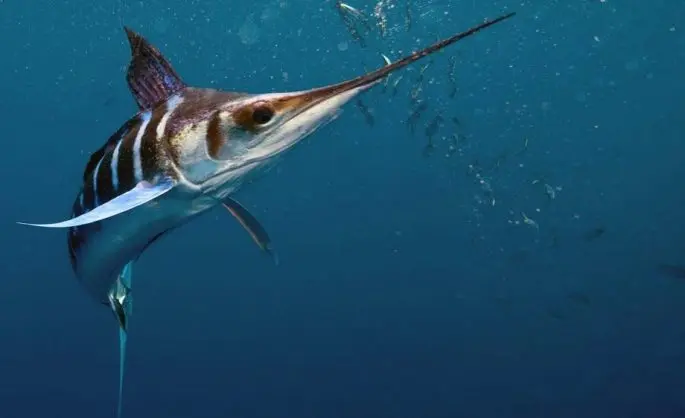
Marlin fish tend to prefer to stay closer to the surface of the water and away from the shoreline. When moving, this fish can swim at a considerable speed, while often jumping out of the water several meters in height. If you take the fish of a sailboat, then it easily accelerates to a speed of 100 km / h, or even more. Therefore, representatives of this species are among the fastest fish that live on our planet.
Marlin is a typical predator and leads a solitary life, overcoming up to 75 kilometers during the day. Representatives of this family are more subject to seasonal migrations. During these periods, fish travel thousands of kilometers. According to numerous observations of experts, the movement of marlin in the water column strongly resembles the movement of sharks.
How long do marlins live
Female blue marlin live 25% longer than males, who live to around 18 years of age. Females can live up to 25 years. Sailfish live no more than 15 years.
Types of marlin

For all types of marlin, a characteristic feature is an elongated body shape, a spear-shaped snout and a rather rigid dorsal fin. There are the following types of marlin:
- Indo-Pacific sailboat, which represents the genus “Sailboats”. Sailboats differ from other types of marlin by having a tall and long first dorsal fin that looks more like a sail. This “sail” begins directly at the back of the head and runs along almost the entire back of the fish. The back is black with a blue tint, the sides have the same tint, but are painted brown. As usual, the belly is a silvery-white shade. On the sides of the fish you can see pale blue spots of medium size. The length of young individuals is at least 1 meter, and adults grow up to 3 meters in length and gain weight up to 100 kg, or even more.
- Black marlin. It is of commercial interest, although only a few thousand tons are caught annually. This species is also of interest for sport and recreational fishing. The black marlin has an elongated, although not strongly laterally compressed body, covered with reliable scales. There is not a large gap between the dorsal fins, and the caudal fin is month-shaped. The color of the back is dark blue, and the sides and belly are silvery white. On the body of adults there are no characteristic spots, as well as stripes. Adult individuals grow in length to almost 5 meters, with a body weight of about 750 kilograms.
- The West Atlantic or small spearman represents the genus of “spearmen”. The body of this fish is quite powerful, elongated and strongly compressed laterally. In addition, she has a long and thin spear, round in cross section. The pelvic fins are thin, the length of which is the same or slightly longer than the pectoral fins, which can also be hidden in a depression on the belly. The color of the back is dark, with a blue tint, and the color of the sides is white, with the presence of randomly located brown spots. The color of the belly is silvery white. Small spearmen grow up to 2,5 meters in length, while their weight does not exceed 60 kg.
In addition to these species, there is also the Short-nosed Spearman or the Short-nosed Marlin or the Short-nosed Spearfish, the Mediterranean Spearman or the Mediterranean Marlin, the South European Spearman or the North African Spearman.
Including Atlantic White Spearman or Atlantic White Marlin, Striped Spearman or Striped Marlin, Atlantic Blue Marlin or Blue Marlin, and Atlantic Sailfish.
natural habitats
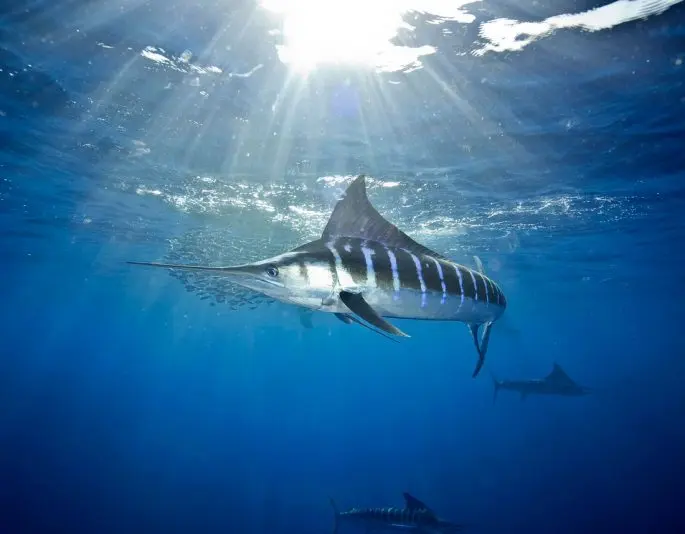
The marlin family includes three main genera and dozens of different species that differ in habitat conditions. Sailfish are more common in the waters of the Red, Mediterranean and Black Seas. At the same time, they enter the Mediterranean Sea through the Suez Canal, after which they easily appear in the Black Sea.
Blue marlin are considered representatives of the waters of the tropical and temperate latitudes of the Atlantic. Their main habitat is represented by its western part. Black marlin prefer the waters of the Pacific and Indian Oceans, located in the coastal zone. There are especially many of them in the waters of the East China and Coral Seas.
Spearfish are marine pelagic oceanodromous fish that lead an isolated lifestyle, although sometimes they form small groups that include fish of the same size. This species prefers open waters, with depths up to 200 meters and a temperature regime of about +26 degrees.
Marlin diet
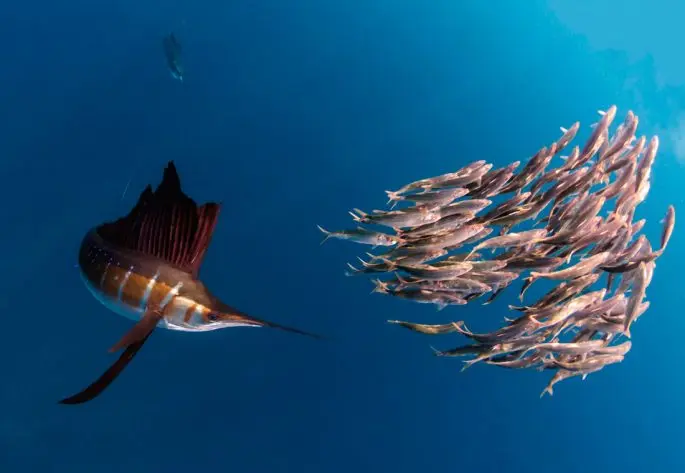
All types of marlin are classic predators whose diet includes other types of fish, squid and crustaceans. Within the territorial waters of Malaysia, the basis of the marlin diet is anchovies, various types of horse mackerel, flying fish, and squid.
The main food of sailboats is small fish that live in the upper layers of the water, including sardines, anchovies, mackerel and mackerel, as well as crustaceans and cephalopods. Atlantic blue marlin fry prefer to feed on zooplankton, as well as eggs and larvae of various fish species. Adults eat fish and squid. Within coral reefs, blue marlin prey on small coastal fish.
Western Atlantic spearmen hunt fish and cephalopods in the upper waters, and their diet is much more varied. In the southern waters of the Caribbean, their diet includes herring and Mediterranean longfin. In the western Atlantic Ocean, the basis of the diet is Atlantic sea bream, snake mackerel and cephalopods of various species.
Spearmen, representing the northern subtropics and tropics of the Atlantic, mainly feed on fish and cephalopods. Up to 12 species of different fish were found in the stomach of the caught marlin.
Marlins on the hunt (Marlin)
Reproduction and offspring

Small spearmen, representing the northern and southern hemispheres, mature in the same calendar terms, which indicates the homogeneity of this species of marlin. Females of this species spawn only once during the year.
Black marlins go to spawn in conditions when the water temperature reaches +28 degrees, while the spawning period depends on the climatic conditions of the entire region. Representatives of the waters of the South China Sea go to spawn in late spring or early summer, and within the territorial waters of Taiwan, this process begins in August and ends in September. The northwestern waters of the Coral Sea are characterized by the fact that marlin spawn here from the beginning to the end of autumn. The female lays eggs in stages, while she is able to lay up to 40 million eggs.
Sailfish spawn in late summer or early autumn in warm equatorial or tropical waters. Individuals do not show any concern for their future offspring, especially since sailboats have pelagic caviar, which drifts in the water column under the influence of the force of the current. All types of sailboats are also distinguished by high fecundity. In the process of spawning, the female lays, in general, up to 5 million eggs, in several stages.
It is important to know! After birth, marlin fry develop quite quickly and under favorable conditions, their growth is up to 15 mm per day.
Most of the marlin offspring die at the stage of caviar, as well as at the stage of fry. And this is not surprising, since many species of predatory fish of the world’s oceans eat caviar and fry.
Natural enemies
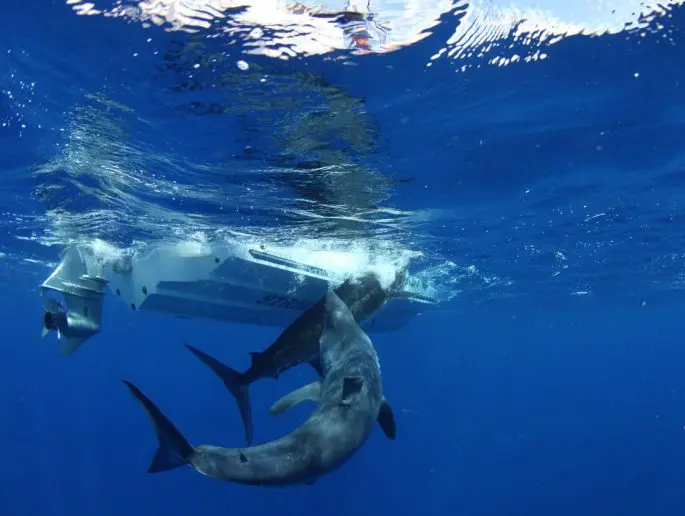
Atlantic blue marlins, as well as blue marlins, are prone to attack by white sharks and mako sharks. In addition, experts managed to determine over a long period of observation that blue marlin suffer from many types of parasites (up to 3 dozen). Sticky fish quite often settle on the body of such fish, especially in the area of gill covers.
Blue marlin, which are quite large in size, can attack no less large white marlin. And yet it is believed that the main enemy of marlins is man, since sailboats are of commercial interest. As a result of longline fishing, sailboats are caught in nets along with fish such as tuna or swordfish.
Important fact! Off the coast of many countries, local fishermen practice spinning sailboats. This is a very interesting fishing that requires high skill and reliable gear.
Population and species status
Nowadays, active production of marlin on an industrial scale is carried out in the Indian Ocean. The percentage of the world catch of marlin is quite high, while Japan and Indonesia are the most active marlin fisheries. For catching marlin, special longline nets are used. Marlin is the dream of every sports angler, as well as an amateur fisherman.
Despite such high interest, today most of the marlin caught are released back. Marlin meat is considered a delicacy, which is why they are caught commercially, which leads to a decrease in the total number of marlin. In this regard, this fish was listed in the Red Book as a “vulnerable species”.
A film by Oleg Lyadenko. Looking for MARLIN
Marlin fish in cooking
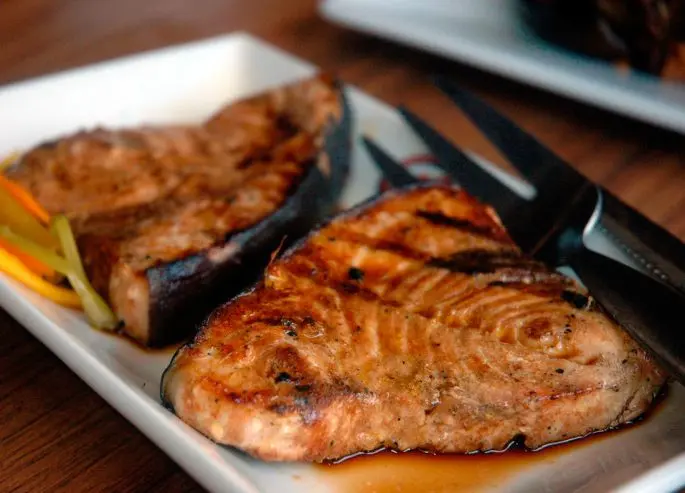
This fish is known to culinary experts all over the world, because it is believed that the taste characteristics of marlin are similar to those of tuna. Therefore, marlin dishes can only be tasted in restaurants where they are prepared by highly qualified chefs. You can safely replace tuna meat with marlin meat when preparing various haute cuisine dishes, which is often done. The meat of this fish is used, and quite often, for the preparation of traditional Japanese sushi. In addition, you can cook delicious first courses from marlin meat, as well as bake it on coals.
Marlin fish meat is characterized by the fact that it has a fairly low percentage of fat, so it is not recommended to fry it too much. In connection with this nuance, it is believed that the ideal cooking option for this meat is grilling. This is the only way to ensure that the finished dish is juicy, tender and soft. If the meat of this fish is fried in oil in a pan, then it will turn out to be no less tasty, but at the same time its energy value increases.
The healthiest fish meat is raw meat. It retains all the useful substances. Lightly salted marlin meat is used to prepare various cold appetizers. At home, it is better not to cook it or cook it with full confidence that it is not infected with parasites.
Raw marlin meat has a reddish tint, but in the process of cooking this shade changes to pink-yellow. The meat has a fairly elastic and dense texture, including a pleasant taste.
Marlin fish meat, like many other seafood, is rich in various useful components, including omega-3 polyunsaturated fatty acids. In this regard, meat is recommended to be consumed in order to regularly replenish the body with vitamins and minerals, which have a beneficial effect on the work of many systems of the human body. The presence of useful substances can improve a person’s mood, reliably protecting him from depressive conditions. The low fat content makes this meat indispensable for the preparation of dietary dishes. Its energy value is at a level of just over 100 kcal per 100 grams of product. Therefore, for those who follow their figure, this meat is ideal. It will not interfere with those who want to get rid of extra pounds.
In conclusion
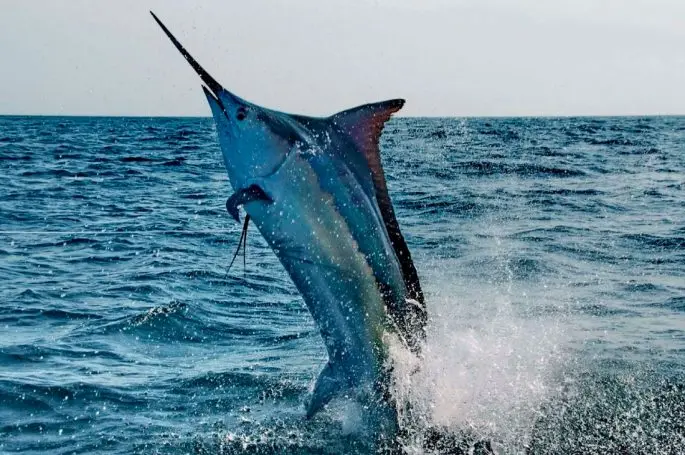
To catch such a fish, many professional anglers spend huge amounts of money and travel thousands of kilometers. The fact is that many countries make money on this by organizing this type of fishing. Often this is very dangerous, since fishing is carried out on the high seas. Yes, and the fish is not small, so if there is no proper experience, then it can easily drag the angler along with it. Unfortunately, there were such cases, but this does not stop real fans of extreme sports. There is a whole category of such fishermen who purposefully hunt such monsters and nothing else.
Therefore, we can safely say that the main enemy of this fish is a person who does not think about the consequences.
It should also be noted that today this fish is expensive and rare, so those who are going to cook and taste this fish will have to try hard to find this fish on store shelves. Although, on the other hand, our time is characterized by the fact that there is almost everything on the shelves of stores, but there is nothing to buy it all for. No less important is the fact that you still need to be able to cook marlin meat, otherwise the next time all the desire to buy and cook it will disappear. According to those who have encountered such a problem, the main thing is not to overdo it in the pan, then you will be able to feel all the charm of its taste. In addition, it is not recommended to get carried away with seasonings and spices, which can clog the natural taste of fish, and at the same time spoil the taste of the dish.









